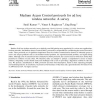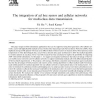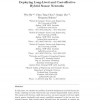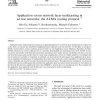107
Voted
ADHOC
2006
15 years 27 days ago
2006
Most ad hoc networks do not implement any network access control, leaving these networks vulnerable to resource consumption attacks where a malicious node injects packets into the ...
104
Voted
ADHOC
2006
15 years 27 days ago
2006
Routing in ad-hoc networks is a complicated task because of many reasons. The nodes are low-memory, lowpowered, and they cannot maintain routing tables large enough for well-known ...
101
Voted
ADHOC
2006
15 years 27 days ago
2006
119
Voted
ADHOC
2006
15 years 27 days ago
2006
Studies of ad hoc wireless networks are a relatively new field gaining more popularity for various new applications. In these networks, the Medium Access Control (MAC) protocols a...
105
Voted
ADHOC
2006
15 years 27 days ago
2006
Self-organization of wireless sensor networks, which involves network decomposition into connected clusters, is a challenging task because of the limited bandwidth and energy reso...
108
Voted
ADHOC
2006
15 years 27 days ago
2006
This paper targets mobile telemedicine applications that can be supported using third generation (3G) cellular networks, to provide highly flexible medical services. On the other ...
76
Voted
ADHOC
2006
15 years 27 days ago
2006
In this paper, we consider the problem of network deployment in hybrid sensor networks, consisting of both resource-rich and resource-impoverished sensor devices. The resource-ric...
103
Voted
ADHOC
2006
15 years 27 days ago
2006
ct 9 It is often useful to know the positions of nodes in a network. However, in a large network it is impractical to build a 10 single global map. In this paper, we present a new ...
122
click to vote
ADHOC
2006
15 years 27 days ago
2006
Application layer multicasting has emerged as an appealing alternative to network layer multicasting in wireline networks. Here, we examine the suitability of application layer mu...
109
Voted
ADHOC
2006
15 years 27 days ago
2006
In wireless ad hoc sensor networks, energy use is in many cases the most important constraint since it corresponds directly to operational lifetime. Topology management schemes su...






